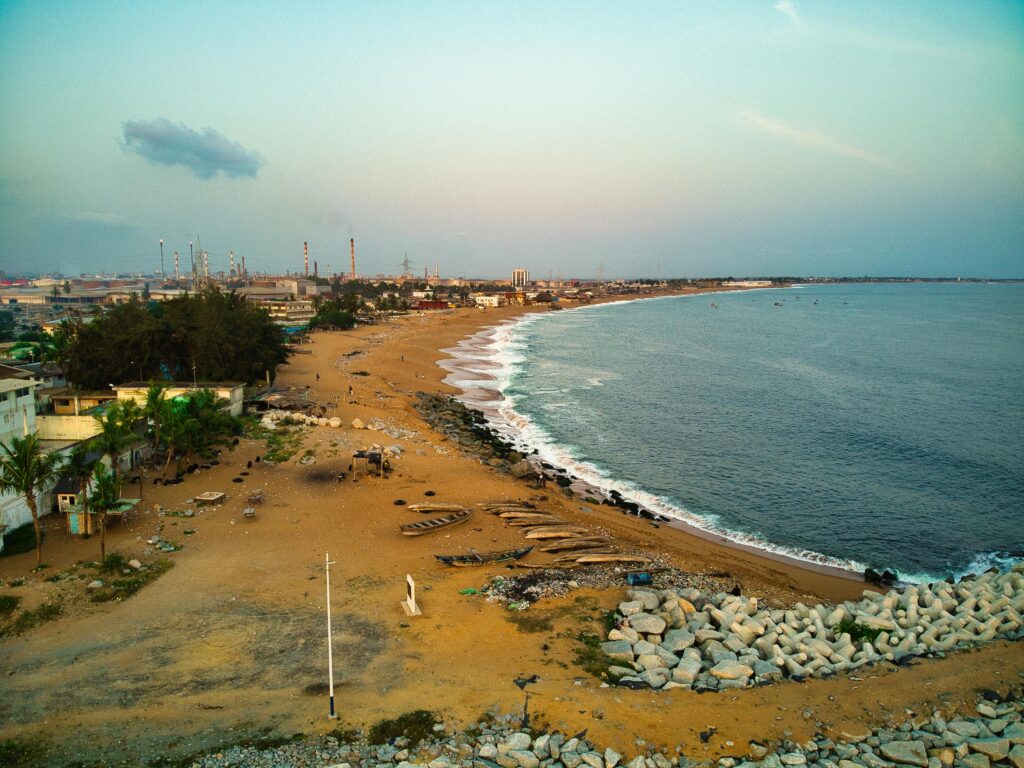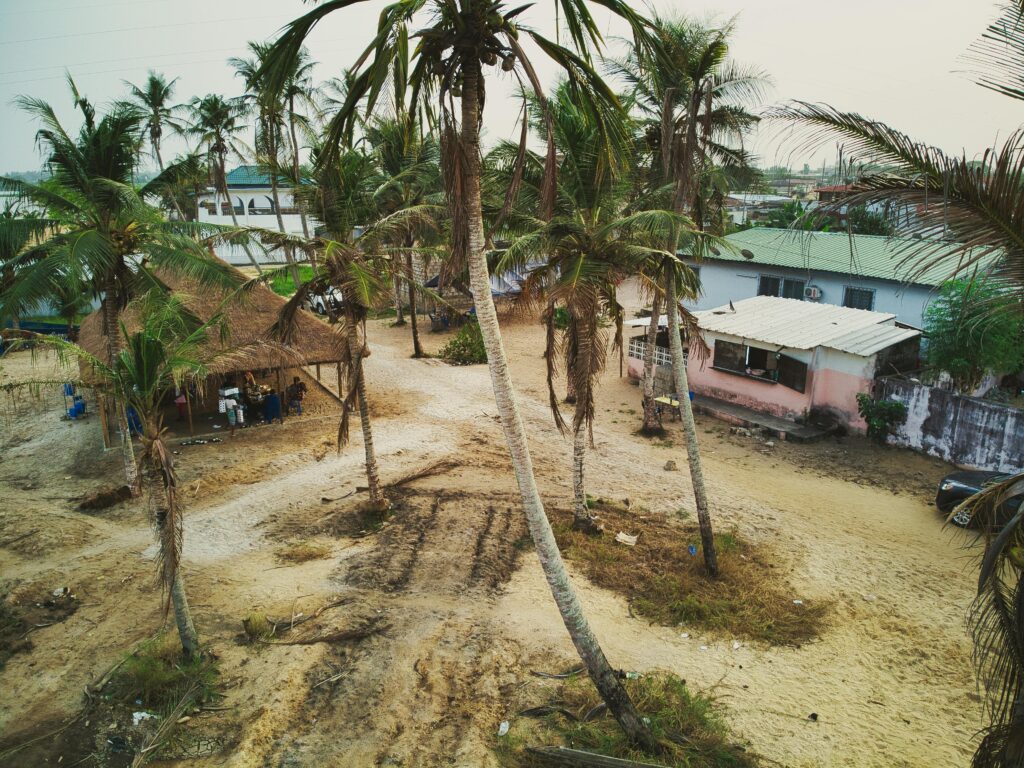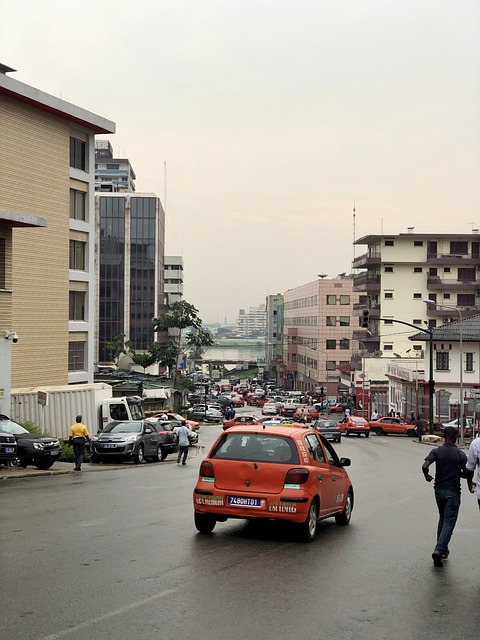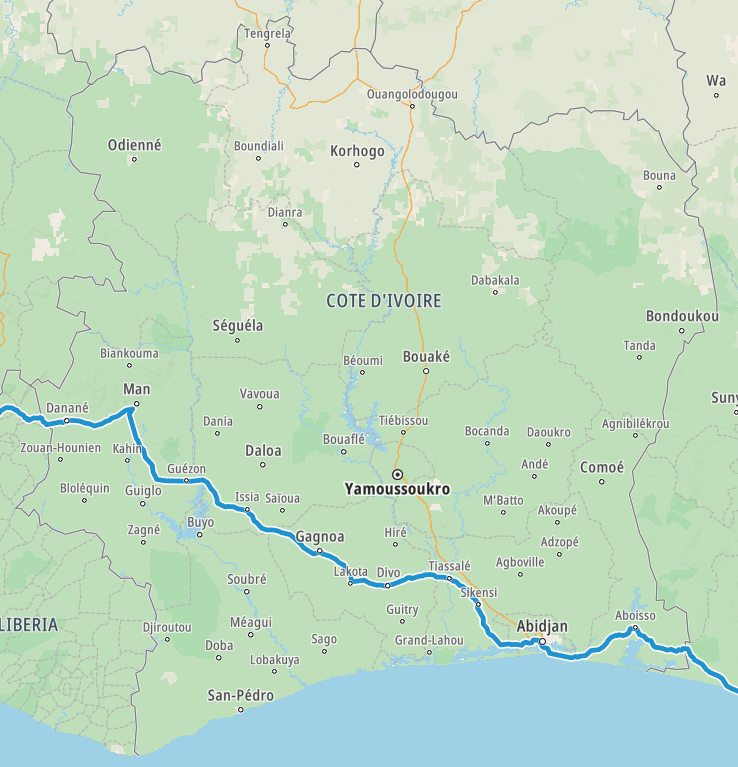Cote d’Ivoire / République de Côte d’Ivoire – Let’s explore here

What’s it like in Cote d’Ivoire?
Cote d’Ivoire, also known as the Ivory Coast, is a fairly flat, agricultural country in west Africa. The highest point in the country is Mount Nimba, on the western border with Guinea, at 5,748 ft (1,752 m) above sea level.
About the size of Norway, It consists mostly of farmland for the production food and cocoa beans – for which it is the world largest exporter. It has a very long, rich and troubled history – although currently its experiencing one of the fastest growth rates in the world. It shares its land borders with Guinea, Liberia, Mali, Ghana and Burkina Faso.
The population of Cote d’Ivoire is around 31½ million people (2024), around 420,000 of whom live in the capital city, Yamoussoukro. By contrast, more than one in five of its citizens live in its former capital, Abidjan.

A bit about the history of Cote d’Ivoire
Early History and Indigenous Groups
The region now known as Côte d’Ivoire has been inhabited by various ethnic groups for centuries, with the major groups including the Akan, Krou, Mandé and Gour populations. These groups had well established societies with complex political and cultural systems. Trade networks existed between the interior of West Africa and the coastal areas, where kingdoms such as the Sanwi and the Kong Kingdom were prominent.
Colonial Period and French Rule
In the late 19th century, European powers scrambled to colonise Africa. France took control of Côte d’Ivoire in 1893, and it became part of French West Africa. The French established plantations, especially for crops like cocoa and coffee, and exploited the local population through forced labour. The country’s economy was heavily reliant on the export of these agricultural products. During the colonial period, there were several uprisings and resistance movements, but France maintained control until independence.
Path to Independence
After World War II, nationalist movements advocating for independence grew across Africa. Côte d’Ivoire’s push for independence was largely peaceful compared to other African nations. In 1958, Côte d’Ivoire became a self governing republic within the French Community, and on 7 August 1960, it gained full independence from France. Félix Houphouët-Boigny, who had been a prominent leader in the independence movement, became the country’s first president. He played a key role in shaping the country’s early political and economic development.
Houphouët-Boigny’s Rule and Stability
Under Houphouët-Boigny’s leadership, Côte d’Ivoire became one of the most stable countries in West Africa. He pursued policies of economic growth, focusing on agricultural exports, particularly cocoa and coffee, and encouraged foreign investment. The country became one of the world’s largest exporters of cocoa. Houphouët-Boigny’s government was largely one party, and political opposition was suppressed. He was regarded as a father figure of the nation and ruled until his death in 1993, overseeing a period of relative peace and economic prosperity.
Political Instability and Civil War
After Houphouët-Boigny’s death, political instability grew as his successor, Henri Konan Bédié, struggled to maintain control. In 1999, a military coup ousted Bédié, marking the beginning of a period of heightened political turmoil. The country’s political division deepened between the predominantly Christian and southern based government and the Muslim and northern based opposition. In 2002, a civil war broke out when rebels from the north, led by Guillaume Soro, launched an insurgency against the government. The war was halted by a ceasefire in 2003, but the country remained divided between the government controlled south and the rebel held north. During this time, tensions between ethnic and regional groups intensified, and the political situation remained fragile.
Post-War Recovery and Political Tensions
The post civil war period saw the rise of new political leaders, including Laurent Gbagbo, who became president in 2000. Gbagbo’s presidency was marked by increasing tensions between him and his main political rival, Alassane Ouattara, who represented the northern Muslim majority areas. In 2010, after disputed elections, Gbagbo refused to step down, claiming victory despite international recognition of Ouattara as the winner. This led to a violent conflict between Gbagbo’s supporters and Ouattara’s forces, with thousands of deaths and widespread violence. Gbagbo was eventually arrested and transferred to the International Criminal Court.
Alassane Ouattara’s Presidency and Recent Developments
Alassane Ouattara, who became president after the 2010 crisis, has overseen a period of reconstruction and economic recovery. He has focused on rebuilding the country’s infrastructure and stabilising its economy, largely based on oil, cocoa and coffee exports. Despite this, political tensions and ethnic divisions continue to affect the country. In 2020, Ouattara was re-elected for a controversial third term, sparking protests and violence. His decision to run again, despite an amendment to the constitution limiting presidential terms, led to opposition claims that he was seeking to extend his power undemocratically.
Modern Côte d’Ivoire
Côte d’Ivoire is now one of the fastest growing economies in Africa, with significant investments in infrastructure, agriculture and services. However, political and ethnic divisions remain a challenge. The country continues to deal with the aftermath of the civil war, with reconciliation and unity still ongoing. Côte d’Ivoire is one of the world’s largest producers of cocoa, but the country faces challenges related to poverty, corruption and human rights concerns. Despite these issues, it remains a key player in the West African region, with a relatively strong economy and growing international influence.

Ivory Coast road trip
Our Ivorian road trip is part of a much larger African road trip.
Map of our planned road trip through Cote d’Ivoire

Our current planned road trip through Cote d’Ivoire takes us from Liberia down towards the capital, Yamoussoukro, and Abidjan on the coast, before moving on to Ghana.
No doubt we’ll explore the country much more than this continent-spanning short route shows, in particular checking out inland Ivory Coast.
Hopefully our journey will improve our knowledge of this intriguing and beautiful country, and enable us to meet some interesting people. We’ll be updating this page at that time – don’t forget to check back 🙂
What’s it like to drive in Cote d’Ivoire?
They drive on the right hand side of the road in the Ivory Coast. In the main, roads are very poor, with many being unsurfaced dirt tracks. Driving standards are also poor.
Do you require an international driving permit in the Ivory Coast?
We’ve created a dedicated page to driving abroad, which answers this question, and more, which you might find helpful.
Can you use your UK driving license when driving through the Ivory Coast?
We’ve created a dedicated page to driving abroad, which answers this question, and more, which you might find helpful.
Do I need a carnet de passages to drive in the Ivory Coast?
We’ve created a dedicated page to driving abroad, which answers this question, and more, which you might find helpful.
What is the weather like in Cote d’Ivoire?
The rainy season in the Ivory Coast is from April to October. The dry season is from November to March. The best time to visit is between December and February. The worst months are May to July.
What currency do they use in Cote d’Ivoire?
In the Ivory Coast they use the West African CFA franc. Cash is widely used. The use of credit / debit cards is not widely accepted. Travellers cheques are not readily accepted. There are few ATMs in cities and towns throughout the country.
The West African CFA franc is used in Benin, Burkina Faso, Guinea-Bissau, Côte d’Ivoire, Mali, Niger, Senegal and Togo.
You should make yourself aware of the amount that your bank charges you for using credit and debit cards abroad. Often credit cards are cheaper for purchasing items directly, and for withdrawing cash from ATMs.
What language do they speak in Cote d’Ivoire?
They speak French in the Ivory Coast. Kwa, Senufo and Mande are also widely spoken. English is not widely spoken.
What time zone is the Ivory Coast in?
Remember, when you’re planning your next trip to take a look at what time zone it’s in.
Do I need a visa to visit the Ivory Coast?
We’ve created a dedicated, more comprehensive page on visas, which you should find helpful. Check it out!
Is wild camping legal in Cote d’Ivoire?
Yes, wild camping is fine in the Ivory Coast.
What plug / socket type do they use in the Ivory Coast?
In Cote d’Ivoire they use plug / socket types C and E.


Health issues in the Ivory Coast
Is it safe to drink water in Cote d’Ivoire?
No, it is not safe to drink tap water in the Ivory Coast. Bottled water is readily available throughout the country.
What vaccinations are required for the Ivory Coast?
This NHS website is kept up to date with all relevant information on vaccinations in Cote d’Ivoire.
Phones in Cote d’Ivoire
What is the country calling code for Cote d’Ivoire?
The country calling code for the Ivory Coast is +225
What are the emergency phone numbers in the Ivory Coast?
- The emergency number for police in Cote d’Ivoire is: 110 / 111 / 170
- In Cote d’Ivoire, the emergency number for ambulance is: 185
- The emergency number for fire in Cote d’Ivoire is: 180
If you’ve got some useful info that you’d like to share, let us know!
And don’t forget to check out all the other pictures!
